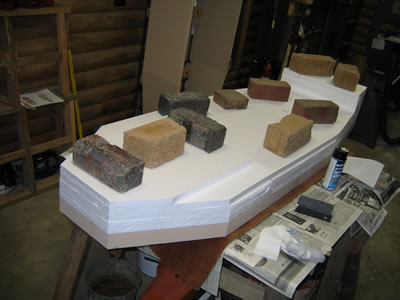
|

|
| Start with a plain pine coffin, from a recent
production of Oliver! Devise a way to attach the box firmly to
a hand cart. We used two thick hardwood pieces inside of the case and
two corresponding pieces outside, with our appliance mover sandwiched
between. It was all held together with four large carriage bolts. |
Add extra bracing to the inside of the coffin lid, and
paint everything inside and out a neutral color. With a black magic marker,
draw the design for the inside of the lid, and color it in. We used water-soluable
latex paint for everything. |

|

|
| Once the inside of the lid is finished, build up the top
with layers of Styrofoam. The foot and head are higher then the rest,
so they get more layers of foam. We cut the foam with a bandsaw and used
a spray-on adhesive to stick it all together. We used bricks to weigh
it down while the glue dried. |
Once the glue had dried, it was easy to shape the foam
with a palm sander with coarse (50 grit) sandpaper. |

|

|
| Since the script calls for the lid to be slammed shut
quickly, we were concerned about the possibility of the whole built-up
part breaking off during a performance. To fix this, we belted the built-up
part to the wooden lid with three cloth bands stapled securely to the
wood. With the bands in place, we trowled on a thin layer of stucco patching
compound over the whole lid. [Thanks to the friendly folks at Schell
Scenic for suggesting that we use stucco.] |
Here's another shot of the stucco process and the reinforcing
bands. No matter how smooth you are with the putty knife, stucco dries
to a rough finish. We experimented with sanding the stucco, but decided
that the roughness added to the ancient appearance of the mummy case. |

|

|
|
While the stucco dried for a couple of days, we painted
the design on the inside of the case.
|
The next step was to put the lid back on the rest of the
case and magic marker in the design for the lid. We added two sets of
heavy duty magnetic catches to keep the lid closed. The resulting effect
was like closing a refrigerator door.
|

|

|
|
Painting the top of the lid and the sides of the case
finished the project.
|
The inside of the finished mummy case. The central figure
on the lid is the god Ptah-Sokar-Osiris, a symbol of birth, death, and
the afterlife. Above the god are two kneeling men.
Behind the god are three lotus blossoms growing in a river. On the inside
of the case bottom at the top is Nut, the sky goddess (early relative
of the Witch of the East), bearing the sun on her head. Above her is the
eye of Horus. The other two panels display lotus flowers growing in a
river and a woven design.
|

|

|
|
The outside of the mummy case lid. At the top is a portrait
of the woman for whom the mummy case was made, who wears an elaborate
wig and collar and carries two ankhs, which symbolize life. Below her
is the solar bird. At the bottom are two winged falcons, sacred to the
god Horus, who was the son of Isis and Osiris. Each falcon bears a sun
on its head.
|
The side of the mummy case, with alternating hierglyphs
of reed leaves and water.
*Note: In case you reached this site without going through
the Athenian Berean Community Players site,
the pictures here show the mummy case that we built for our May 2006 production
of Moss Hart and George S. Kaufman's comedy The Man Who Came to Dinner.
|












